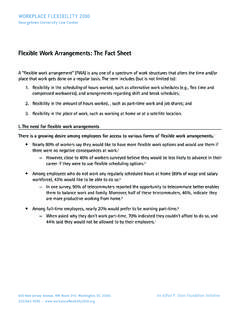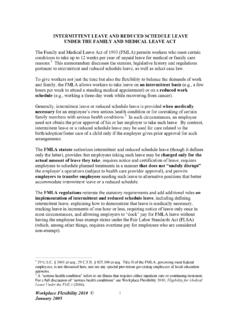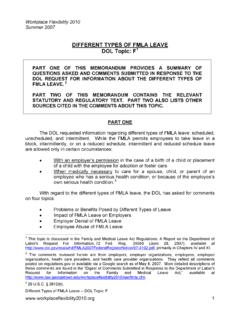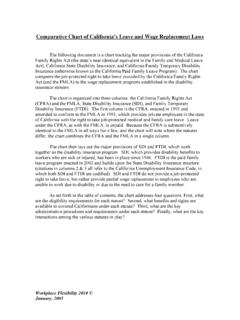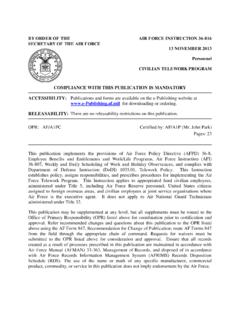Transcription of Telework in the Federal Government: The Overview Memo
1 Telework in the Federal government : The Overview memo Flexible Work Arrangements (FWAs) alter the time and/or place that employees work on a regular basis in a manner that is manageable and predictable for both employees and Telework , also called telecommuting, refers to an FWA that enables an employee to work from an alternative place to the employer's usual worksite, typically home or a satellite work center. Telework technically refers to work performed with the use of a telecommunications connection to the workplace ( , computer, telephone), but the term is also used more generally to describe any type of work done from a remote location. Telework can provide many benefits to employees, employers and society as a whole, including work and family balance, increased accommodations for people with disabilities, alleviation of significant commuting/transportation challenges, cost reduction, reduced carbon emissions, and emergency preparedness.
2 There remain, however, challenges to implementing Telework in an effective and systematic fashion. The Federal government has employed a range of public policy approaches to increase access to Telework , including legislation, appropriations and guidance from the Office of Personnel Management (OPM) and the General Services Administration (GSA). Although the results of the government 's policies have varied among Federal agencies, the government 's approach serves as an important case study of the utility of various public policy approaches to increase access to and utilization of Telework , as well as other FWAs. The purpose of this memorandum is to provide an Overview of the Federal government 's use of Telework arrangements. This memo : o explains Telework and the benefits it offers to employers, employees and society;. o sets forth the Federal government 's current policies for offering Telework options to employees and provides a status update on the current use of Telework in the Federal government ; and o describes common challenges that Federal employers experience when implementing Telework programs and highlights characteristics that have helped certain agencies implement successful Telework programs.
3 1. See 1. I. Telework Overview A. What is Telework Telework , also called telecommuting, is a flexible work arrangement (FWA) that allows an employee to work somewhere other than the employer's typical office In addition to working from home, a variety of alternative worksites also exist for teleworkers. Telework options include hot desking, hoteling, virtual offices, and Telework Hot desking is an employment situation in which an employee works in a main office part of the time and from a remote location the remainder of the time. When the employee is in the main office, he or she uses a non- dedicated, non-permanent workspace assigned for use by reservation on an as-needed basis, as opposed to having a reserved office space that goes unused when the employee is Hoteling is similar to hot desking. However, employees must reserve the space they are going to work in ahead of Telework centers are facilities that provide workstations and other office facilities/services that employees from several organizations can Virtual Offices are virtual work environments in which employees can work cooperatively from different locations using a computer An employee can use any of these Telework options in conjunction with other forms of FWAs, such as flextime or part-time work.
4 B. Benefits of Telework Employers are increasingly offering Telework arrangements because of the benefits it produces. For example, the Federal government uses Telework as a tool for recruiting and retaining talented Telework can also increase productivity while 2. See Workplace Flexibility 2010, Telecommuting: A Case Study in Public Policy Approaches (2006), available at 3. See Federal Management Regulation, Guidelines for Alternative Workplace Arrangements, FMR. Bulletin 2006 B3, 71 Fed. Reg. 52 (March 17, 2006), pp. 13845, available at 4. Id. 5. Id. 6. Id. 7. Id. 8. See Status of Telework in the Federal government : Report to Congress, Office of Personnel Management, at 2 (December 2008), available at (hereinafter 2. decreasing costs for office space, and can ensure continuity of business operations during an Employees benefit from a better work/life balance, improved morale, and reduced commuting and transportation Finally, society at large benefits from reduced traffic congestion and emissions, emergency preparedness ( pandemic response) and reduced infrastructure impact in urban II.)
5 Telework Policies in The Federal government The Federal government was an early leader in Telework , adopting and implementing new laws and policies to address the needs of the Federal workforce. The following section provides an Overview of the history, legislation, agency guidance, and appropriations implemented to bolster Telework in the Federal government . A. A History of Telework in the Federal Workforce: The 1990s 1. Flexiplace Pilot Projects In 1990, the Office of Personnel Management (OPM), in conjunction with the General Services Administration (GSA), initiated the Federal Flexible Workplace Pilot Project to assess the benefits and challenges of allowing employees to work at locations other than their government office base (so-called flexiplace ).12 According to OPM and GSA, the administrative rationales behind sponsoring flexiplace programs were to improve the retention and recruitment of employees, increase productivity, and reduce the expanding needs for office Early monitoring of the pilot indicated both difficulties in facilitating flexiplace participation as well as some preliminary benefits.
6 Originally, the government expected about 2,000 Federal workers to be involved in the pilot project. However, as of February 1992, only about 550 employees were participating in the pilot project. Most of these employees were from the Environmental Protection Agency, the Equal Employment Opportunity Commission (EEOC), the Department of Health and Human Services, and the Department of Status of Telework 2008). According to a report conducted by the General Accountability Office (GAO), 53% of all Federal employees with dependent care needs said that workplace flexibility options were an important factor in accepting employment with the government and 67% said it was an important factor in their decision to continue to work in the public sector. Gen. Accountability Office, An Assessment of Dependent Care Needs of Federal Workers Using the Office of Personnel Management's Survey, GAO- 07-437R007) at 34, available at 9. See Status of Telework 2008, at 2.
7 10. Id. 11. Id. In 2007 60% of Federal agencies reported that Telework was fully integrated into their COOP/emergency planning, up from 42% in 2006. Id. 12. General Accounting Office, Report to the Ranking Minority Member, Subcommittee on Civil Service, Committee on government Reform and Oversight, House of Representatives, Federal Workforce: Agencies' Policies and Views on Flexiplace in the Federal government , GAO/GGD-97-116, 1997 (hereinafter GAO Report 1997 ) at 1, available at 13. GAO Report 1997 at 5. 14. General Accounting Office, Report to Congressional Committees, The Changing Workforce: Comparison of Federal and Nonfederal Work/Family Programs and Approaches, GAO/GGD-92-84, 1992. at 82, 3. Despite the low level of utilization, the initial evidence from the pilot project indicated that flexiplace initiatives could improve productivity and lower For example, the EEOC found that productivity among the investigators who participated in the flexiplace pilot program improved, as measured by the increased number of interviews they conducted while participating in the The Defense Investigative Service found that allowing special agents and industrial security specialists to work out of their homes eliminated office space at government facilities that produced cost A July 1997 government Accountability Office (GAO) evaluation of employees'.
8 Experiences with flexiplace policies revealed many of the anticipated benefits of this FWA: reduced commuting time; lowered personal costs for items such as transportation, parking, food and wardrobe; and improvement in the quality of work-life and morale accruing from the employee's opportunity to better balance work and family A 1998 OPM assessment found that 73% of surveyed agencies reported implementing some flexiplace 2. Infrastructure Funding: The 1990s Based on the early successes of the OPM pilot project, Congress sought to use its power of appropriations to enable and encourage Federal agencies to fund the phone lines and equipment, computer connection fees, and Telework centers that would be needed to support flexiplace workers effectively. The Treasury, Postal Service, and General government Appropriation Act of 1990 was the first Congressional act to explicitly include funds for flexiplace The Treasury, Postal Service, and General government Appropriations Act of 1996.
9 Provided that any Federal employer could use Federal funds to install telephone lines and other equipment in an employee's home, and could pay the monthly service charges for such lines and equipment, for Federal employees authorized to use Before funds could be used for such purposes, the agency head was required to certify that: 1). 15. Id. 16. Id. 17. Id. 18. GAO Report 1997 at 12. This evaluation was based primarily on five Federal departments and three independent agencies. Additionally, people with disabilities experienced some reduction in the workforce participation barriers they faced. Id. 19. This data was based on the response of 61 Federal agencies, which collectively represented approximately 95% of the Federal workforce, excluding the Postal Service. See Office of Personnel Management, A Review of Federal Family-Friendly Workplace Arrangements (1998). While 73% of the agencies reported implementing some flexiplace program, as the data below indicate, most Federal employees still do not Telework .
10 20. Treasury, Postal Service, and General government Appropriations Act of 1991 624 (enacted as Pub. L. No. 101-509, 104 Stat. 1389 (1990)). 21. See Treasury, Postal Service, and General government Appropriations Act of 1996 620, 31 1348 note (2000) (enacted as Pub. L. No. 104-52, 109 Stat. 468 (1995)). 4. the agency had implemented adequate measures against misuse of funds and 2) the service was necessary to directly support the agency's The Omnibus Consolidated Appropriations Act of 1997 allowed GSA to create Telework centers for use by Federal , state, and private sector employees (with priority for Federal employees).23 The Act also required that executive agency heads contemplating the acquisition of additional physical workspace had to consider whether Telework centers would satisfy their need Finally, beginning in fiscal year 1999, Congress created a more direct incentive for agencies by setting aside $50,000 of the funds annually appropriated to each agency for the agency to spend on employee usage of Federal Telework 3.
